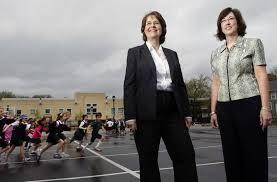|
Catholic ombudsman alarmed by reports of students sexually abusing other students
By Mark Morris
When the Catholic Diocese of Kansas City-St. Joseph child abuse ombudsman took the job three years ago, she was prepared to occasionally be surprised by what crossed her desk. But Jenifer Valenti, a former Jackson County prosecutor, now sees something that goes beyond surprise. Valenti wrote in a recent report to the diocese that she was “alarmed” by increasing reports of students in local Catholic schools sexually abusing other students. The youngest case involved a 3-year-old preschooler acting out sexually with classmates, she said. “It is shocking to get a minor-abusing-a-minor call,” Valenti said. But if Valenti wanted to compare her figures with those of the surrounding public school districts, she’d find it challenging because of a blind spot in federal law. Three years ago, the U.S. Department of Education launched an effort to have public primary and secondary schools deal more aggressively with student-on-student sexual abuse. But those officials did not require schools to report what they found. The federal laws in question are Title IX, which defines the sexual abuse of students as gender discrimination, and its cousin the Clery Act, which mandates public reporting of campus crime by colleges and universities, said Colby Bruno, senior legal counsel for the Victim Rights Law Center in Boston. In addition to institutions of higher education, Title IX covers any primary and secondary public school system that accepts federal money. But Clery does not require public schools to report statistics on sexual abuse and violence, as it does for colleges and universities. That, Bruno said, is a big “loophole.” Without such data, schools cannot understand the scope of the sexual violence, abuse and harassment problems their students face. Kindergarten through 12th grade students “are totally under the radar,” Bruno said. “We’re still in the dark ages with high school.” Valenti has seen peer-on-peer sexual abuse reports rise from 10 complaints in her 2012-13 report to 18 in her 2013-14 study, which she released in September. She had no such reports in her first reporting year, 2011-2012. Today, peer sexual abuse reports make up about 17 percent of the complaints she investigates, up eight points from the previous year. More than 11,000 children are enrolled in the region’s Catholic schools, said Carrie Cooper, director of the diocesan Office of Child and Youth Protection. Valenti acknowledged that her rising peer abuse statistics could reflect greater awareness among thousands of diocesan clergy, staff and volunteers who have undergone training over the the last three years on how to spot and report sexual abuse. But greater awareness is part of the program, she noted. The diocese moved to strengthen its sexual abuse reporting program three years ago, after church leaders delayed for five months telling authorities about a priest, Shawn Ratigan, who later pleaded guilty to producing child pornography. A Jackson County judge also found Bishop Robert Finn guilty of a misdemeanor count of failure to report suspicions of child abuse. Julie Donelon, president of the Metropolitan Organization to Counter Sexual Assault, cautioned that she deals with dozens of public school systems and they do take peer abuse seriously. But without data and a point person who deals specifically with sexual abuse, the public school response to complaints can be “fragmented” and difficult to quantify, she said. The benefits to devoting more attention to the issue are immense, Donelon said. The victim and the abuser can get treatment, which has proven remarkably effective for youthful perpetrators, she said. “The research shows us that children, with proper therapeutic intervention, have a very low rate of recidivism,” Donelon said. “What’s really exciting is that the Catholic diocese is tracking these children and making those referrals.” Some children from the diocese could be treated in a counseling program for abusers 10 to 14 years old her organization recently established with a federal grant. Schools do report some crime data to the state as part of their obligations under the No Child Left Behind Act. But totals for 23 crimes — including first-degree murder, forcible rape and first-degree robbery — are lumped together in one “violence” category for each school, with no way to distinguish the sex crimes. More information could be on the way soon, said a spokesman for the U.S. Department of Education. The department’s Office for Civil Rights will begin collecting sexual violence information from school districts in the 2015-16 school year, he said. Though Valenti is not pleased to see rising numbers on this kind of abuse, she’s happy to have spotted the trend so early in her program’s history. “One of the goals of our program is to be proactive and not reactive,” Valenti said. “We feel this can make a direct difference in a family’s life.” Contact: mmorris@kcstar.com
|
.
Any original material on these pages is copyright © BishopAccountability.org 2004. Reproduce freely with attribution.
